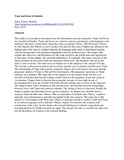| dc.description.abstract | This study is an attempt to investigate how the information structure categories: Topic and Focus are encoded in Kiembu. Topic and Focus are syntactic sentence constituents with pragmatic roles and hence the need to study these categories using a pragmatic Theory. The Relevance Theory by Dan Sperber and Wilson is used to analyse the data for this study.
Chapter one introduces the background of the study is outlined whereby the language under study is introduced together with the background to the problem is highlighted and the problem stated. The chapter also outlines the objectives and hypotheses for the study and gives the justification and significance of this study. In this chapter, the research methodology is explained. The major concepts of the theory adopted are discussed under the theoretical framework. The literature relevant to this study is also reviewed.
The main focus of chapter two is the analysis of the concept of Topic. The concept is discussed in general and in a more specific way as sentence and discourse Topic. The relationship of Topic and syntactic categories subject and word order is discussed and the pragmatic relation of Topic to Old and New information. The pragmatic operations on Topic elements are explained. The main aim of this chapter is to investigate Topic and how it is encoded in Kiembu showing the existing relation between the pragmatic Topic
and syntactic 'correlations.
Chapter three is directed discussing the concept of focus with an aim of investigating how focus is encoded in Kiembu and the existing types of focus in the language. The chapter opens with a definition of the concept focus and then discusses the relationship between focus with Topic and syntactic relations. The coding of focus is discussed. Finally the chapter explains the determined focus can be contrastive.
In chapter four, Klembu data is analysed under the Relevance Theory. The two principles of the Relevance Theory; cognitive principle and communicative principle are applied in the data analysis. The main aim of this chapter is to investigate if the Relevance Theory is adequate enough to analyse Topic and Focus in an African language such as Kiembu. Finally, chapter five presents the summary and conclusions of the study. In this chapter, the research findings are outlined, suggestions and recommendations for further research are made. The chapter also tries to examine the objectives and the hypotheses in relation to the research findings. | en_US |

